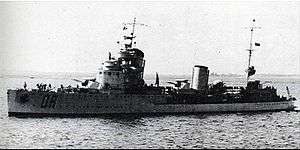Battle of Skerki Bank
| Battle of Skerki Bank | |||||||
|---|---|---|---|---|---|---|---|
| Part of the Battle of the Mediterranean of World War II | |||||||
 The Navigatori-class destroyer Nicoloso da Recco, seriously damaged in the Battle of Skerki Bank | |||||||
| |||||||
| Belligerents | |||||||
|
|
| ||||||
| Commanders and leaders | |||||||
|
|
| ||||||
| Strength | |||||||
|
3 light cruisers 2 destroyers |
3 destroyers 2 torpedo boats 4 troopships | ||||||
| Casualties and losses | |||||||
| None2 |
1 destroyer sunk 1 destroyer heavily damaged 2 torpedo-boats heavily damaged 4 troopships sunk 2,033 - 2,200 killed | ||||||
|
1one ship in the convoy was German 2one destroyer was sunk during the dawn before the battle by aircraft with the loss of 20 servicemen | |||||||
The Battle of Skerki Bank was a World War II naval battle which took place near Skerki Bank in the Mediterranean Sea on the early hours of 2 December 1942 between British and Italian forces, as the last major naval battle in the Mediterranean during 1942.
Background
The British force consisted of the light cruisers HMS Aurora, Argonaut and Sirius with the destroyers HMS Quentin and HMAS Quiberon. The squadron was under the command of Rear Admiral C. H. J. Harcourt.
On the night of 2 December, they found and attacked an Italian convoy and its escort bound for Tunisia. The convoy consisted of three destroyers and two torpedo boats: the German KT-1 (850 tons), Aventino (3,794 t), Puccini (2,422 t), and Aspromonte (a militarized and armed ferry-boat, 976 tons). The ships were carrying with reinforcements for General Rommel's Africa Corps. It included 1,766 troops, 698 tons of cargo (mainly ammunition), four tanks, 32 other vehicles, and 12 artillery pieces. The escort was relatively strong: destroyers Nicoloso da Recco (flagship), Camicia Nera, Folgore and the torpedo boats Clio and Procione which were commanded by Captain Aldo Cocchia.
Battle
The British ships hit opened fire and destroyed, one after the other, all the cargo and troop ships. The escort ships were hit as well, with Folgore fatally damaged (9 133 mm direct hits) by cruisers, and later sunk with 120 dead (among them, commander Ener Bettica), Nicoloso da Recco badly damaged (an explosion of the forward 120 mm ready ammunition magazines put her out of commission until June 1943, and killed or wounded half the crew) with 118 dead. Camicia Nera launched all her 6 torpedoes, which missed their targets. HMS Sirius escaped with no damage despite Camicia Nera firing on her from only 2 kilometres (1.2 mi), dodging several torpedoes and continued cooperating in the sinking of the other Axis ships.
Aftermath
At dawn, the short-range engagement saw a clear British victory, while the Axis suffered no fewer than 2,000 casualties (probably 2,037 or even 2,200, the total is uncertain) and lost five ships, with Puccini still afloat, but to later sink. Whilst they were withdrawing Savoias attacked Q-Force, without result but losing some aircraft. Spitfires claimed four Sparvieros with one loss, while HMS Quentin was sunk with 20 dead by a 500 kg bomb released from a Junkers Ju 88. (Possibly the hit scored was actually a torpedo.) On the other side, the human losses were 124 from Folgore, 118 from Nicoloso da Recco, 39 from Aspromonte, 3 from Procione, 200 civil/militarized crew and 1,527 troops, all in Aventino and Puccini[1]
External links
References
- ↑ Sgarlato, Nico: Lo scontro del banco di Skerki, Eserciti nella Storia magazine, Delta editions, Parma, gen-feb-2012, p.23-25
Coordinates: 37°45′12″N 10°57′12″E / 37.75333°N 10.95333°E